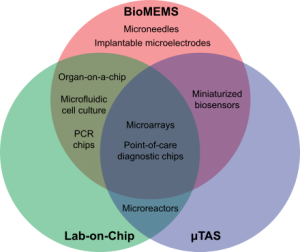Note: While technically the application of Bio-MEMS Devices are currently being created for the use of sensors, scanning, and detection, I have a slight idea on how this technology can be used for our endeavor.
Many times I wrote articles that talk about what I find from doing a reverse link research to see what kinds of websites reference this website. Today I found a link to this website from a website which referenced a very unique, new biomedical technology which is just coming out.
The exact link that referenced this website is http://investorshub.advfn.com/boards/read_msg.aspx?message_id=92029467
The post that they referenced was the one where I had talked about the potential in using the Low Intensity Pulse Ultrasound LIPUS technology to possibly help increase height.
Increase Height And Grow Taller Using Low Intensity Pulsed Ultrasound, LIPUS – Part II
In the post I had mentioned a bone stimulator device known as Exogen which emits a LIPUS waves to increase the healing rate of bones which are in non-union. The EXOGEN LIPUS product is known as a Ultrasound Bone Healing System.
The poster on the website link above stated or quoted this phrase….
“David ‘Rocky’ Markus started research on a ‘male reproductive organ-enhancement device’
according to my sources using EPGL‘s latest LIPUS– technology. Results will be revealed next week and a prototype-device…:can be expected by the end of September”
They noted that either the new biomedical device or technology using LIPUS would be a $50 Billion industry. So What I did like I always did was do a little bit of research on this company, to see what they did.
In the past I had uncovered information about Biomet Non-Invasive Bone Growth Stimulator System called OrthoPak. I would eventually say after doing more research and conclude that the Biomet uses the LIPUS technology which does not help in increasing height, at least for people with completely ossified growth plate cartilage.
It seems that a company EP Global Communications Inc which has the stock ticker name EPGL has been renamed to EPGL Medical Sciences back in earlier of this year (2013) has developed a certain type of biomedical technology using the LIPUS technology.
A certain Ph. D scientist named David “Rocky” Markus (Ph.D. in Biomedical Engineering and a MS in Electrical Engineering with an emphasis in MEMS Microelectronics and Biomedical) has developed a very unique way to help males increase their penis size (aka male reproductive enhancement device). using the LIPUS technology. A real MD named Corey W Hunter came on to the board as some type of scientific advisor and the medical director.
When I typed in the term “EP Global Communications” into google to see what I can find about this company, I was taken to another forum post about this company which is becoming more and more interesting http://investorshub.advfn.com/EP-Global-Communications-Inc-EPGL-7241/
From the main webpage, the are…. “focused on developing and marketing medical devices for both diagnosis and treatment of chronic pain”. It is very interesting since I am currently developing a small website selling devices that are used to treat pain and provide pain relief devices (exactly Electrotherapy Devices, TENS Units, Transcranial Direct Current Stimulation tDCS Devices, and Infrared Therapy Devices). So I am curious.
EPGL Med has come out with its first product, something called the MPDD. The MPDD stands for Muscle Pain Detection Device. The function of the MPDD medical device is to help physicians detect the exact point of pain origination in muscles. From the website…
“The MPDD device incorporates leading edge technology for trans-cutaneous-electroneural stimulation, a safe, effective and proven way of stimulating muscle”
It seems that the technology is very similar to the Transcutaneous Electrical Nerve Stimulation technology seen in TENS devices. The claim is quite impressive.
Beyond just this MPDD Pain Locator Device, there are additional products that they are developing which they describe as “biomedical devices which utilize Bio-Micro-Electro Mechanical Systems technology (Bio-MEMS)”
What are Bio-Micro-Electro Mechanical Systems?
 The name is shorten to Bio-MEMS. Based on the Wikipedia article on Bio-MEMS, it seems that the primary function of any type of Bio-MEMS is to help treat some type of disease or diagnose a disease. The scale that Bio-MEMS work on are on the micro-scale. What happens is that you take elements of various branches of science and engineering like material science, electrical engineering, biology, and genetics and combine them together to build cool stuff. You use the BIo-MEMS in genomics, proteomics, implantable devices, and tissue engineering.
The name is shorten to Bio-MEMS. Based on the Wikipedia article on Bio-MEMS, it seems that the primary function of any type of Bio-MEMS is to help treat some type of disease or diagnose a disease. The scale that Bio-MEMS work on are on the micro-scale. What happens is that you take elements of various branches of science and engineering like material science, electrical engineering, biology, and genetics and combine them together to build cool stuff. You use the BIo-MEMS in genomics, proteomics, implantable devices, and tissue engineering.
As for company EPGL Medical Sciences, they now hold rights to at least one FDA 510k cleared medical device. The MPDD is claimed by the company to be worth over $4 billion dollars annually in revenue sales and recurring revenues.
What is shocking to me is that the company is one of the first biomedical device designers and makers which have implemented and are using the Google Glass technology and the API Mirror platform.
The last little bit which really got me interested is that the claim EPGL Med has some type of secret medical technology that they are currently not revealing until they manage to patent the hell out of the technology. Supposedly, EPGL will reveal its new BioMEMS medical device platform which is called “TopSpin.”
From PRWEB.com, they revealed back in June what type of devices and patents were being written up
EPGL has filed patents and owns unique Intellectual Property for each of the following new smart medical devices:
- 1. A new advanced ablation device for nerve pain treatment in the back.
- 2. A new advanced ablation device for nerve treatment of Facial Glabballar Frowning.
- 3. A new advanced device for elimination of facial wrinkles.
- 4. A new advanced Epidural device.
- 5. A new advanced power source for TopSpin medical devices.
- 6. A new and promising device for treatment of Retinitis Pigmentosa
- 7. A new and promising device for treatment of Macular Degeneration
- 8. A new and promising treatment for Hearing Loss
- 9. A new more accurate treatment for trigger points in the muscles (MPTT)
- 10. A new advanced device for treatment of prostate tumors.
- 11. A new advanced endoscopic device.
- 12. A new advanced device for delivery of micron sized drug payloads.
- 13. A new advanced device for delivery of micro mechanical devices into the body.
- 14. A new advanced device for biopsy.
- 15. A new advanced device for stem cell treatment delivery.
- 16. A new advanced contact lens device.
Several more devices beyond this list will be revealed in coming months by the Company.
I have a little bit of experience in learning about patent laws, and I have worked with patent lawyers in my older company which was a startup trying to create an alternative energy storage system. Patents are a huge industry, where large corporations go into multi-billion dollar lawsuit wars over proprietary issues with Non-Disclosure Agreements thrown around everyday.
Theoretically we could try to find the patent on Google Patents or see what type of ideas they could potentially be. We don’t plan to build our own device since that is not our intention.
For some interesting reading I would like to refer the reader to the patent “Method of making BIO-MEMS devices“
I have worked in finance also before trading securities and I know only a little bit of these unique angel investors or venture capitalists. I have known about Sand Hill Road for years now and I understand that for so many venture capitalist firms, they wait and just get reports coming out of small startup companies which a brilliant new technology hoping to invest and buy enough of a company which will turn into the next Google or Facebook.
So what does all this information have to do with us, people who are searching for a way to possibly increase height?
If we look at some of the types of application that Bio-MEMS devices can be used for, one of them is for implantable devices and tissue engineering. #13 and #15 of the claims made by this rather hot biomedical device startup are that they have created devices which can delivery of micro mechanical devices into the body and do delivery of stem cells. These are the type of technology which I have been hoping for to come along.
I currently don’t have the resources and the financial capital to set up a real lab and get test trials done, but I can do enough research to be able to connect the major dots. If we can find enough patents, reports, studies, and Ph. D thesis, we just might theoretically create a theory on how to increase longitudinal growth in the long bones which is based on scientific references.
I refer back to the amazing patent written by Carl Brighton almost 30 years ago. “Method for non-invasive electrical stimulation of epiphyseal plate growth“. He had written up the patent as a scientific advisor or maybe CTO (Chief Technology Advisor) for the company Biolectron Inc.
It seems that Biolectron was doing some major research on how to grow bones even 30 years ago. Biolectron Inc might not be around anymore but the patents and the intellectual property still exists for us as amateur researchers to read and think about.
As a final note, I would like to refer to another amazing patent written also by Brighton and Solomon Pallock back in 1983. Patent: Method for treatment of non-union bone fractures by non-invasive electrical stimulation
The patent did show that if you applied some type of electrical stimulation or force, you would indeed be able to grow bone, and heal bone non-unions very fast, just like most LIPUS devices claim today.


